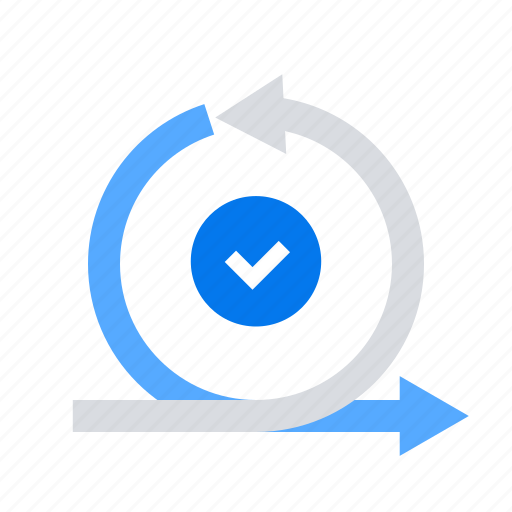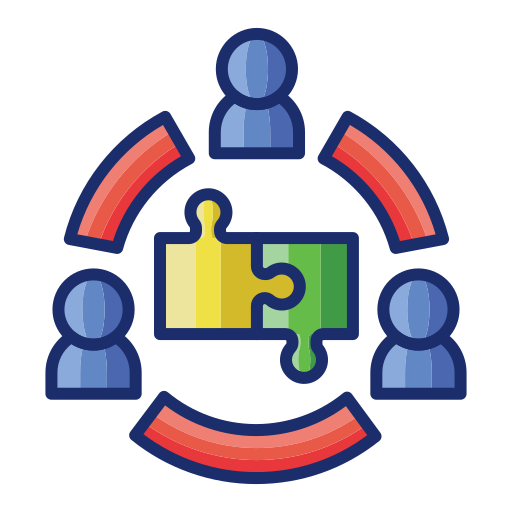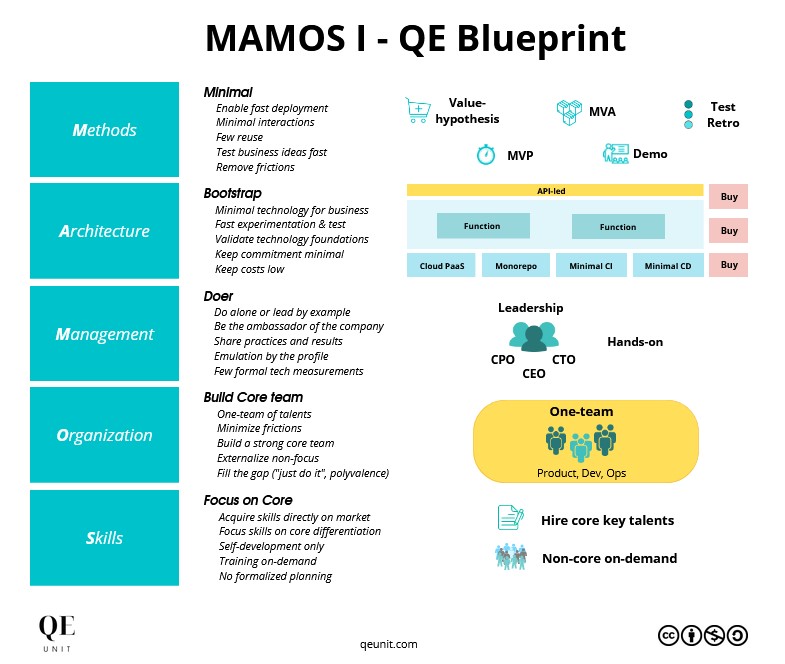MAMOS I is the first level of the Quality Engineering blueprint designed to establish a baseline of software development practices, and to begin the process of standardizing these practices across the organization. This level also focuses on establishing a culture of continuous improvement and innovation, which is essential for long-term success in the software development industry.
Model Fit
At this level, organizations are typically just starting to adopt digital products and services, and the focus is on establishing a foundation for software development.

Discover value
The main focus is not yet to scale the business, but to discover value.

Build the MVP
The main focus is to deliver the MVP with Quality at Speed software.

Small team
Usually between $0-2m of annual revenues of 3-10 FTEs.
QE Blueprint
The MAMOS I level is characterized by a basic set of software development practices, which are typically not fully documented or standardized.

MAMOS
Methods
“Minimal”
The methods in MAMOS I are designed to help teams collaborate more effectively, build the right product, and deliver it quickly to customers.
- Value-hypothesis
- MVP
- MVA
- Demo
- Retrospective
Guiding Principles
- Enable fast deployment
- Minimal interactions
- Few reuse
- Test business ideas fast
- Remove frictions
Key Changes
- Collaboration product and tech
- Mock-ups and UX are tested
- MVP must be delivered
- Things change fast and pivot
- Coordination is largely informal through direct interactions
Key Choices
- Features prioritization
- Scope of MVP
- Minimal contacts to include
- Minimal processes to setup
- What to document
Key Actions
- Discovery and experiments
- User research and mock-ups
- Implement POC and MVP
- Focus on improving minimal features
- Coordinate to simplify fast
ARCHITECTUR
“Bootstrap”
Bootstrapping is building a flexible and scalable technology infrastructure that can support the continuous delivery of a minimum viable product (MVP) and architecture (MVA).
- API-led
- Functions
- Cloud PaaS
- Monorepo
- Minimal CI
- Minimal CD
Guiding Principles
- Minimal technology
- Fast experimentation & test
- Validate tech foundations
- Minimal commitment
- Keep costs low
Key Changes
- Users personas are discovered
- Problem and solution refined
- Architecture can rapidly pivot
- Tech solutions are assessed
- Product core start to emerge
- Minimal standards definition
Key Choices
- Core functions to implement
- Make or Buy
- Technologies for core product
- Technical architecture
- Minimal security
- Flexibility vs. speed
Key Actions
- Implement the POC and MVP
- Support value/scale hypothesis
- Assess core technologies
- Integrate with key 3rd-parties
- Setup foundations to iterate
- Rework and improve core
MANAGEMENT
“Doer”
We recognize that startups operate in a fast-paced and uncertain environment – we aim to provide management guidance that can help teams stay agile, focused, and productive.
- Core team
- CEO
- CPO
- CTO
- Hands-on
- Show by example
Guiding Principles
- Do alone or lead by example
- Be the company ambassador
- Share practices and results
- Emulation by the profile
- Few formal tech measurements
Key Changes
- Co-founders have to hire
- Vision has to be shared
- Values and culture shaping
- Performance from more people
- More alignment is needed
Key Choices
- Vision want to share
- Values part of the company
- Actions as leading by example
- First staffing decisions
- Key objectives
Key Actions
- Clarify the vision and ambitions
- Share the business model
- Lead as wanting others to act
- Define values and show them
- Invest time in shaping culture
- Clarify space for decision
ORGANIZATION
“Build core team”
Building a strong core team enables the organization can move forward with a shared vision, purpose, and direction.
This involves identifying the right people with the necessary skills and expertise, establishing a culture that fosters teamwork, and providing the necessary support to ensure the team’s success.
- One-team
- Product
- Engineering
- Infrastructure
- Externalize non-core
- Fill the gap
Guiding Principles
- One-team of talents
- Minimize frictions
- Build a strong core team
- Externalize non-focus
- Fill the gap (“Just do it”)
Key Changes
- New interactions happen
- People shows their adaptability
- Organization boundaries show
- Organizational culture emerges
- Work mainly direct interactions
Key Choices
- Who to hire for CEO, CPO, CTO
- Culture and values want
- First hiring decisions
- Choices of external partners
- Hybrid-only packages
Key Actions
- Build the core team
- Staff software engineers
- Align development process
- Clarify role responsibilities
- Document light on-boarding
SKILLS
“Focus on core”
The team requires the necessary skills and knowledge to execute on the vision and build a successful product.
The key focus on the core skills that are critical and unique for the success of the product is essential to continuously improve and refine these skills throughout the company’s growth.
- Hire key core talents
- Externalize non-core
- Flexible partners
- Remote only or hybrid
- Remuneration packages
- Work policies
Guiding Principles
- Focus skills for differentiation
- Externalize non-core
- Acquire core skills directly
- Use on-demand pools
- Use flexible partners
Key Changes
- Core skills must be identified
- Initial team owns all knowledge
- Hard to find adequate member
- Complementarity is main asset
- Low visibility in future skills
Key Choices
- Core company skills
- Minimal knowledge writing
- Compromise on first hiring
- Key expertise required
- Partners to work with
Key Actions
- Identify core skills required
- Document minimal knowledge
- Hire key core talents
- Assess and contract partners
- Invest in core specific skills